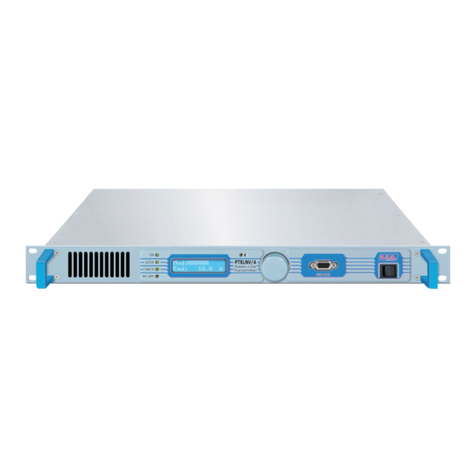
TEX1002LCD
User Manual
1. Preliminary Instructions
• General Warnings
This equipment should only be operated, installed and
maintainedby“trained”or“qualied”personnelwhoarefamiliar
with risks involved in working on electric and electronic circuits.
“Trained” means personnel who have technical knowledge of
equipment operation and who are responsible for their own
safetyandthatofotherunqualiedpersonnelplacedunder
their supervision when working on the equipment.
“Qualified” means personnel who are trained in and
experienced with equipment operation and who are
responsiblefortheirownsafetyandthatofotherunqualied
personnel placed under their supervision when working on
the equipment.
WARNING: Residual voltage may be present inside
the equipment even when the ON/OFF switch is set to
Off. Before servicing the equipment, disconnect the
power cord or switch off the main power panel and
make sure the safety earth connection is connected.
Some service situations may require inspecting the
equipmentwithlivecircuits.Onlytrainedandqualied
personnel may work on the equipment live and shall be
assisted by a trained person who shall keep ready to
disconnect power supply at need.
R.V.R. Elettronica S.p.A. shall not be liable for injury to
persons or damage to property resulting from improper use
oroperationbytrained/untrainedandqualied/unqualied
persons.
WARNING: The equipment is not water resistant.
Any water entering the enclosure might impair proper
operation. To prevent the risk of electrical shock or
re,donotexposethisequipmenttorain,drippingor
moisture.
Pleaseobservelocalcodesandrepreventionruleswhen
installing and operating this equipment.
WARNING: This equipment contains exposed
live parts involving an electrical shock hazard. Always
disconnect power supply before removing any covers
or other parts of the equipment.
Ventilation slits and holes are provided to ensure reliable
operation and prevent overheating; do not obstruct or
cover these slits. Do not obstruct the ventilation slits under
any circumstances. The product must not be incorporated
in a rack unless adequate ventilation is provided or the
manufacturer’s instructions are followed closely.
WA RN IN G: This eq u i p m e n t c an radia t e
radiofrequency energy and, if not installed in compliance
with manual instructions and applicable regulations,
may cause interference with radio communications.
WARNING: This equipment is tted with earth
connections both in the power cord and for the chassis.
Make sure both are properly connected.
Operation of this equipment in a residential area may cause
radio interference, in which case the user may be required
to take adequate measures.
Thespecicationsanddatacontainedhereinareprovided
for information only and are subject to changes without prior
notice. R.V.R. Elettronica S.p.A. disclaims all warranties,
express or implied.While R.V.R. Elettronica S.p.A.
attempts to provide accurate information, it cannot accept
responsibility or liability for any errors or inaccuracies in this
manual, including the products and the software described
herein. R.V.R. Elettronica S.p.A. reserves the right to make
changestoequipmentdesignand/orspecicationsandto
this manual at any time without prior notice.
• Notice concerning product intended purpose and use
limitations.
This product is a radio transmitter suitable for frequency-
modulation audio radio broadcasting. Its operating
frequencies are not harmonised in designated user countries.
Before operating this equipment, user must
obtain a licence to use radio spectrum from the
competent authority in the designated user country.
Operating frequency, transmitter power and other
characteristics of the transmission system are subject to
restrictionsasspeciedinthelicence.
2. Warranty
La R.V.R. Elettronica S.p.A. warrants this product to be free
from defects in workmanship and its proper operation subject
to the limitations set forth in the suppliedTerms and Conditions.
Please read the Terms and Conditions carefully, as purchase
of the product or acceptance of the order acknowledgement
imply acceptance of the Terms and Conditions.
For thelatest updatedtermsand conditions, pleasevisitour web
siteatWWW.RVR.IT.Thewebsitemaybemodied,removed
or updated for any reason whatsoever without prior notice.
The warranty will become null and void in the event the
product enclosure is opened, the product is physically
damaged, is repaired by unauthorised persons or is used for
purposes other than its intended use, as well as in the event
of improper use, unauthorised changes or neglect.
In the event a defect is found, follow this procedure:
1 Contact the seller or distributor who sold the equipment;
provide a description of the problem or malfunction for
theeventaquickxisavailable.
Sellers and Distributors can provide the necessary
information to troubleshoot the most frequently encountered
problems. Normally, Sellers and Distributors can offer a
faster repair service than the Manufacturer would. Please
note that Sellers can pinpoint problems due to wrong
installation.
2 If your Seller cannot help you, contact R.V.R. Elettronica
S.p.A. and describe the problem; if our staff deems it
appropriate, you will receive an authorisation to return
the equipment along with suitable instructions;
3 When you have received the authorisation, you may
return the unit. Pack the unit carefully before shipment;
use the original packaging whenever possible and seal
the package perfectly. The customer bears all risks of
loss (i.e., R.V.R. shall not be liable for loss or damage)
until the package reaches the R.V.R. factory. For this
reason, we recommend insuring the goods for their full
value. Returns must be sent on a C.I.F. basis (PREPAID)
totheaddressstatedontheauthorisationasspecied
by the R.V.R. Service Manager.
IMPORTANT
The symbol of lightning inside a triangle placed on the product, evidences the operations for
which is necessary gave it full attention to avoid risk of electric shocks.
The symbol of exclamation mark inside a triangle placed on the product, informs the user
about the presence of instructions inside the manual that accompanies the equipment, im-
portantfortheefcacyandthemaintenance(repairs).




























